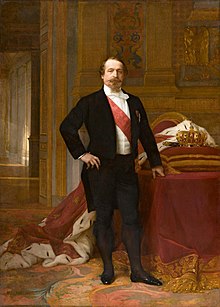Peace of Prague (1866)
The Peace of Prague was a peace treaty dated August 23, 1866 . It was closed (in the Hotel Zum Blaue Stern ) between Prussia on the one hand and the Austrian Empire on the other. Together with other agreements between Prussia and the southern and central German states, the treaty ended the German war .
The agreements reached in the preliminary truce of Nikolsburg on July 26, 1866 to reorganize the German world of states with the exclusion of Austria were thus manifested. In the meantime, the southern German states of Württemberg on August 13, Baden on August 17 and Bavaria on August 22, within the framework of peace treaties with Prussia, joined the Treaty of Nikolsburg.
The preliminary peace had put an end to the German Confederation, which had been the link between the German states for 51 years. A replacement was sought for her. It looked like the southern German states of Württemberg, Baden and Bavaria not only made peace with Prussia, but also entered into secret alliances for protection and defiance.
content

The Austrian government recognized the dissolution of the German Confederation and had to agree to a new design of Germany without Austria's participation. It also agreed to recognize the closer federal relationship that Prussia will establish “north of the line of the Main ”. Austria also agreed that the German states located south of this line form a confederation of states (" Süddeutscher Bund "), which will enter into a "national association" with the North German Confederation and which will have an international, independent existence. However, Prussia had already crossed the Main Line before signing the Peace of Prague by concluding alliances with the southern German states.
An Italy Austria had the Kingdom of Lombardy-Venetia cede. Furthermore, Austria renounced its rights to Schleswig and Holstein in favor of Prussia . On the intervention of Napoleon III. Article 5 of the Treaty of the People of North Schleswig promised a referendum on a possible annexation to Denmark. However, the German Empire and Austria mutually canceled this so-called "North Schleswig Clause" in 1878.

Prussia agreed to leave the territory of the Kingdom of Saxony in its current extent. The Habsburg monarchy did not have to cede any land in the Peace of Prague, and the amount of reparations was low at 20 million thalers. Bismarck wanted to be reconciled with Austria in the medium term. A quick peace agreement was also important in order to ward off French interference or a European peace congress.
consequences
In preliminary talks with France, Prussia's Prime Minister Otto von Bismarck had agreed that the North German Confederation would not cross the Main line. The proposed Südbund or Süddeutsche Bund found little support from most governments in the south. The populations did not warm up either. It was feared that Bavaria would dominate this southern alliance. The independence-related contractual clause remained obsolete in view of the further expansion of the affiliated integration pursued by Bismarck (e.g. the creation of the customs parliament ). Austria's courtship for its allies in 1866 was unsuccessful.
Article 4 gained importance again in 1870. Austria as a contractual partner could have objected to the southern states joining the North German Confederation. Chancellor Beust also made attempts in this direction, but could not obtain Russian support for them. Isolated in terms of foreign policy, Austria opted for a positive stance. With a note dated December 25, 1870, Austria agreed to the establishment of an empire.
See also
Web links
- State treaty between Austria-Hungary and the German Empire of October 11, 1878. In: Reichsgesetzblatt for the kingdoms and countries represented in the Reichsratte , Part X. Issued and mailed on February 18, 1879, pp. 147–149.
- Manfred Jessen-Klingenberg : '' Article V '' . In: Schleswig-Holstein from A to Z. Society for Schleswig-Holstein History, accessed on July 1, 2018 (from: Schleswig-Holstein Lexikon. Edited by Klaus-Joachim Lorenzen-Schmidt and Ortwin Pelc , Neumünster, Wachholtz 2000, ISBN 3 -529-02441-4 ).
supporting documents
- ↑ (caption :) A dwindling historical building in Prague. (...). In: Wiener Bilder , No. 7/1928, (XXXIIIth year), February 12, 1928, p. 5, bottom right. (Online at ANNO ). .
- ↑ For content see the article Peace of Prague In: Conferences and Treaties. Contract Ploetz. Handbook of Historically Significant Meetings and Agreements. Part II. 1493-1952 . Edited by Helmuth Rönnefahrt. Bielefeld: AG Ploetz Verlag, 1953, p. 179 f.
- ^ Compare the content and historical relevance of peace with the lexicon article by Günter Cordes: Prague. Peace from . In: Gerhard Taddey (Hrsg.): Lexicon of German history . People. Events. Institutions . Kröner, Stuttgart 1977, p. 956.
- ↑ Manfred Jessen-Klingenberg: '' Article V '' . In: Schleswig-Holstein from A to Z , Society for Schleswig-Holstein History.
- ↑ Art. I of the State Treaty of October 11, 1878 according to ALEX-online
- ^ Ernst Rudolf Huber: German constitutional history since 1789. Volume III: Bismarck and the realm. W. Kohlhammer, Stuttgart [u. a.] 1963, p. 570.
- ^ Michael Kotulla : German constitutional history. From the Old Reich to Weimar (1495–1934) . Springer, Berlin 2008, p. 527.
